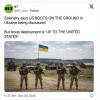
Breaking News
 IT'S OVER - I Have Proof: Fed Opened $24B Credit Line to 3 Banks (Jan 2nd Emergency Emails Leak
IT'S OVER - I Have Proof: Fed Opened $24B Credit Line to 3 Banks (Jan 2nd Emergency Emails Leak
 The Poo Doctor: This Gut Mistake Leads To Cancer. The Cheap Spice That Helps Repair...
The Poo Doctor: This Gut Mistake Leads To Cancer. The Cheap Spice That Helps Repair...
 Vaccine ingredients Exposed - Children's Health Defence "CHD"
Vaccine ingredients Exposed - Children's Health Defence "CHD"
Top Tech News
 Laser weapons go mobile on US Army small vehicles
Laser weapons go mobile on US Army small vehicles
 EngineAI T800: Born to Disrupt! #EngineAI #robotics #newtechnology #newproduct
EngineAI T800: Born to Disrupt! #EngineAI #robotics #newtechnology #newproduct
 This Silicon Anode Breakthrough Could Mark A Turning Point For EV Batteries [Update]
This Silicon Anode Breakthrough Could Mark A Turning Point For EV Batteries [Update]
 Travel gadget promises to dry and iron your clothes – totally hands-free
Travel gadget promises to dry and iron your clothes – totally hands-free
 Perfect Aircrete, Kitchen Ingredients.
Perfect Aircrete, Kitchen Ingredients.
 Futuristic pixel-raising display lets you feel what's onscreen
Futuristic pixel-raising display lets you feel what's onscreen
 Cutting-Edge Facility Generates Pure Water and Hydrogen Fuel from Seawater for Mere Pennies
Cutting-Edge Facility Generates Pure Water and Hydrogen Fuel from Seawater for Mere Pennies
 This tiny dev board is packed with features for ambitious makers
This tiny dev board is packed with features for ambitious makers
 Scientists Discover Gel to Regrow Tooth Enamel
Scientists Discover Gel to Regrow Tooth Enamel
 Vitamin C and Dandelion Root Killing Cancer Cells -- as Former CDC Director Calls for COVID-19...
Vitamin C and Dandelion Root Killing Cancer Cells -- as Former CDC Director Calls for COVID-19...
Sea sponges inspire super strong material for more durable buildings

The team studied how the double lattice structure – seen in the skeleton of a sponge called Venus' flower basket – demonstrated not only impressive strength, but also auextic behavior – the ability to contract when compressed.
"While most materials get thinner when stretched or fatter when squashed, like rubber, auxetics do the opposite," explained Dr. Jiaming Ma, who authored the paper on this bio-inspired lattice structure (BLS) that appeared in Composite Structures in January. "Auxetics can absorb and distribute impact energy effectively, making them extremely useful."
The team at RMIT found that when you combine lattices in a structure similar to a deep-sea sponge, your material of choice can absorb more energy and handle more stress before deforming.
Using the same amount of material, the BLS affords 13 times more stiffness than existing auxetic materials (like those used in heart stents), absorbs 10% more energy, and exhibits a 60% greater strain range than existing designs – meaning it can deform a lot more before it starts to break.
The researchers tested this BLS design by 3D printing a sample made from thermoplastic polyurethane (TPU 95A). Their next step is to produce steel versions of this design for use with concrete to see how it holds up as a construction material.
"We're developing a more sustainable building material by using our design's unique combination of outstanding auxeticity, stiffness, and energy absorption to reduce steel and cement usage in construction," Ma explained. "Its auxetic and energy-absorbing features could also help dampen vibrations during earthquakes."
The BLS design could also find use in protective sports gear and medical products that need to be light but strong.

 "Boots on the Ground"
"Boots on the Ground"


